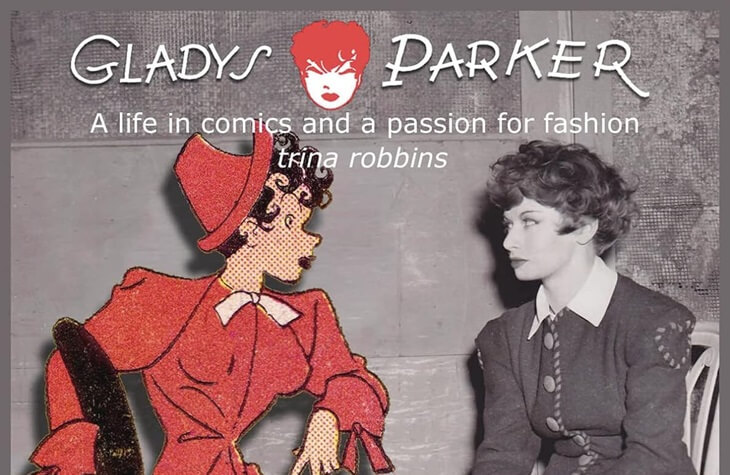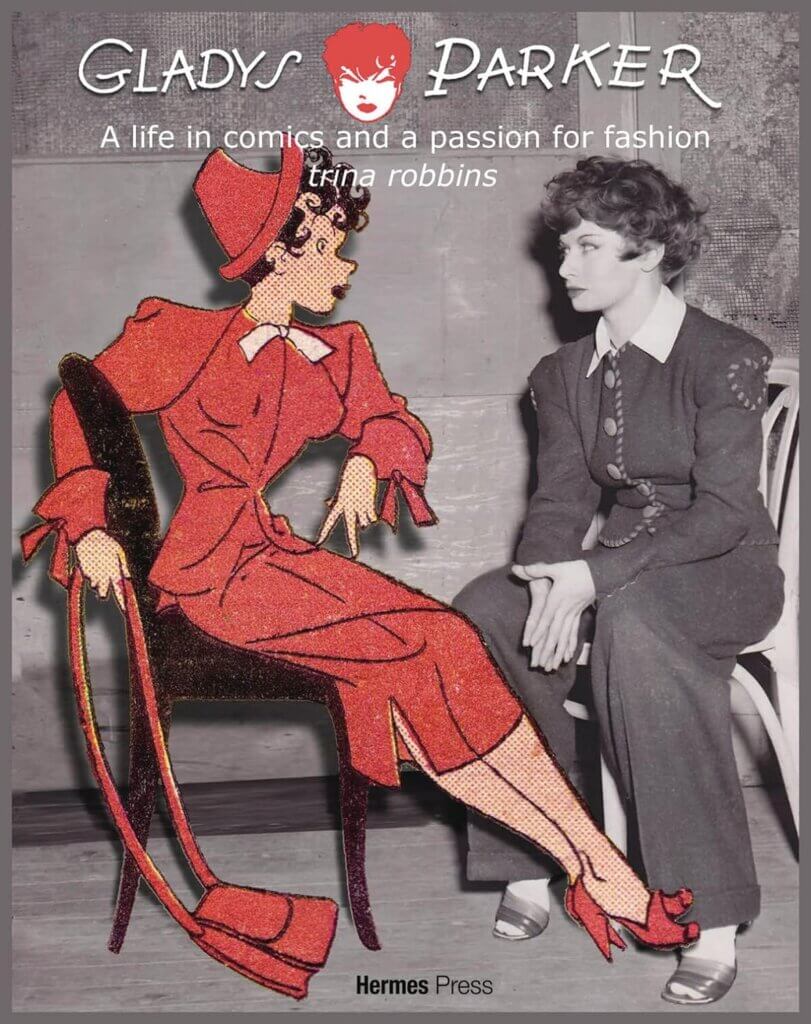I first met Trina Robbins at Comic-Con International: San Diego in 2018 during an annual breakfast organized and hosted by Kim Munson. My friend Michael Dooley was intent on Robbins and I meeting due to shared interests in romance comics and women’s influence in comics history, and made sure we sat next to each other. She showed me her Wonder Woman purse. I showed her a romance comic top I had made for the con, and we discovered we shared a love of fashion and an interest in its intersection with comics. This love is one we have shared ever since.
Even though she might be better known for her work in comics (having initiated the underground women’s comix movement in the 1970s), fashion has always had a place in Robbins’ life. It might surprise some to know that Robbins was involved in fashion long before she started in comics. At times, her two interests have converged, with her comics art appearing in Prada’s Spring/Summer 2018 collection and her most recent (and Eisner-nominated) book, Gladys Parker: A Life in Comics, A Passion for Fashion, focusing on cartoonist and designer Gladys Parker. Overall, Robbins’ involvement and love for fashion deserves broader recognition and, at the very least, to be the focus of a good conversation. Earlier this year, we sat down (over Zoom) to discuss her love of fashion and how it has changed throughout and influenced her life.
Sydney Heifler: Fashion has played a big role in your life. Do you want to explain a bit about your journey as a clothing designer?
Trina Robbins: Okay, well. I just wanted great-looking clothes and I couldn’t buy great-looking clothes, so I decided to make them myself. And my ex-husband bought me a $100 sewing machine. I had learned on my father’s machine, which was a treadle, so I still had to learn how to use an electric one. So, basically, I locked myself into a room with a machine and didn’t come out until I mastered it. And I started making clothes, making the things I wanted to wear that I couldn’t afford to buy, and eventually, what happens is you have so many ideas of things you want to make and your closet can only hold so much so I started selling them at craft fairs. Pretty soon, people knew me and they knew my clothes, especially because I would wear them to dance on the Sunset Strip with very various groups. My ex-husband and I used to get in free because we looked good, because I dressed good, and eventually people asked me to make clothes for them. That’s what I did.
SH: And who are some of your favorite people you made clothes for?
TR: Well, I made some beautiful shirts for David Crosby, a lot of them, but they had all of this heavy lace on the cuffs, you know, they were very romantic and the result was that unfortunately, he couldn’t wear them playing guitar because the lace would get all mixed up with the guitar, but they were gorgeous shirts. But, I loved making clothes in general so everyone was my favorite person to make clothes for.
SH: What was it like to have your style immortalized in the Joni Mitchell song, Ladies of the Canyon?
TR: It was pretty cool when I first heard her sing the song. She said, “Trina, I have a surprise for you,” and then she sang the song and I was just totally thrilled, obviously.
SH: We had talked before about having different wardrobes for different occasions, like how I have my Prada items I wear to various comic cons. What’s in your comic con wardrobe?
TR: I have a very small comic con wardrobe. One of the items is of course my Prada coat, which, of course, is a winner. Unless it is the dead of winter I will wear that coat. I also have a Prada bag that I carry and when I’m not using the Prada bag, because it’s a summer bag, it’s straw, wicker, when it’s not summer I have a couple, three actually, I have three Wonder Woman bags.

SH: I remember. When I first met you, you had a Wonder Woman bag with you.
TR: Yes.
SH: And you also have that cute dress with the horses or the cowgirls on it.
TR: Oh, yes! That’s not just a con dress. That’s a dress that I really love. I got it in Australia. You know, I really have to go far to find my clothes. It’s a great con dress, but it’s also just a favorite dress.
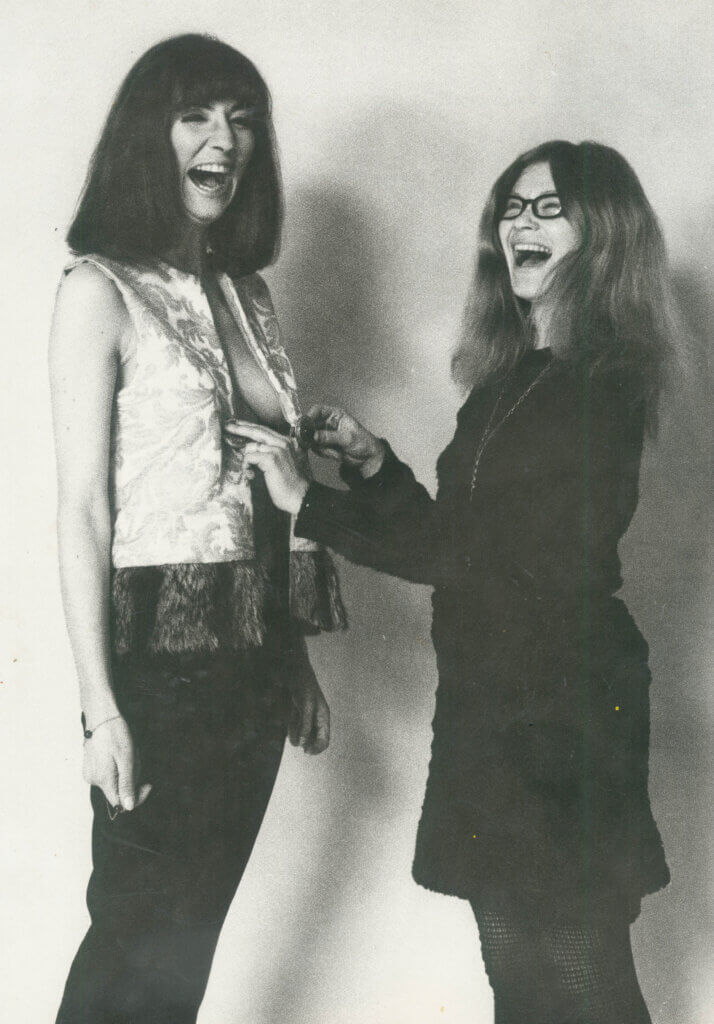
SH: You’re always wearing cute clothes in the photos that you post.
TR: Of course, I’m always wearing cute clothes. No matter what. It’s not hard—you know, right now I’m wearing a scarf because it’s winter. In winter, I’ll dress as cute as I do in summer. It’s a sweater, but it’s a cashmere sweater that I’m wearing and it’s bright blue.
SH: Also, we’ve done some panels together before and we talked about outfits beforehand and I wanted to know how you go about your process, how you go about picking out your outfits for panels. Or, if there is a process?
TR: Well, it’s not like I wear a Wonder Woman costume for a Wonder Woman panel, but I will wear something Wonder Woman-ish. I have a dark blue dress with polka dots on it and it almost looks like it’s got white stars on it. I’ve worn that to Wonder Woman panels, but, mostly, I just wear whatever I’ve brought.
SH: We have been talking some about costumes, cosplay, and fashion. Do you see a relationship between cosplay and fashion?
TR: It depends on the cosplay. My favorite Wonder Woman outfit that I’ve seen in cosplay was this woman whose costume was basically Frida Kahlo Wonder Woman. It was just amazing. I mean, the skirt was blue with the white stars, but it was like a Mexican skirt, you know, a South American skirt. The top was ruffled, but it had a big eagle on it. It was really perfect. But then, you know, there’s the women who wear very little. I still remember there was one Vampirella costume and it was so very, very, very brief, especially the bottom. It was really quite shocking, but she was surrounded by men taking her picture of course. I was actually quite shocked by how brief the bottom was.
SH: Did you want to talk about that costume? We don’t have to talk about it.
TR: No, no. Oh, but I do. There aren’t as many Vampirellas anymore, because she’s old hat, but whenever there is a Vampirella at a con I always take a photo of her. I always send it to Jim Warren, who is the original publisher of Vampirella and he loves it. I send it every Christmas to him.
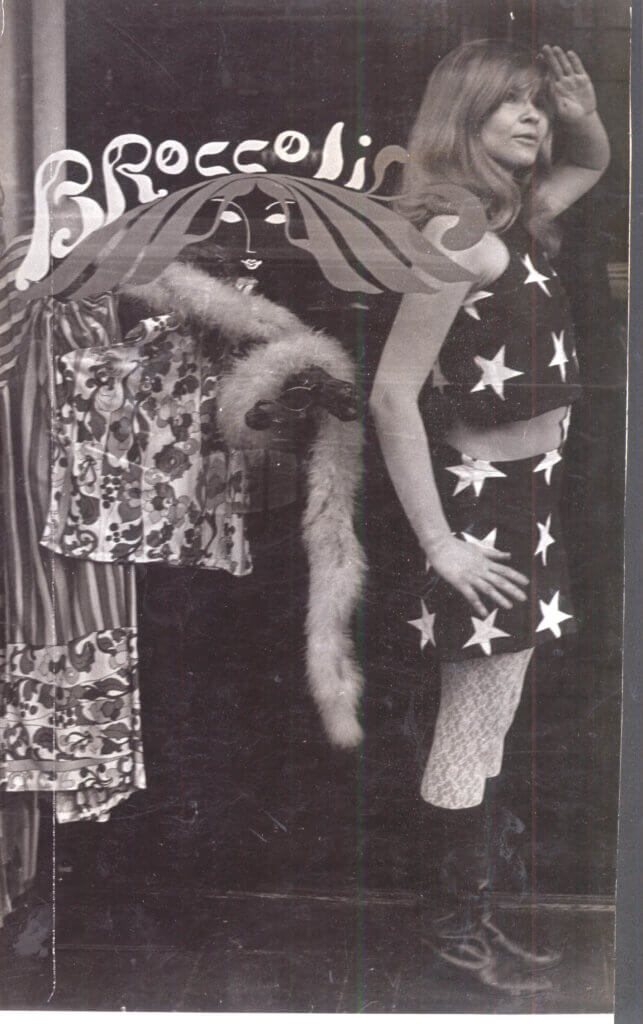
SH: Talking about fashion and comics, 2018 was the Prada collection. That was a direct collision between comics and fashion I feel doesn’t always happen and they did a really good job of it. What was it like to have that moment, of having your work in Prada?
TR: Oh my god, it was incredible. Um, [Miuccia Bianchi Prada] actually invited me to the runway show, but I couldn’t go because I had a signing! And you can’t just skip on signings.
SH: What are your favorite pieces from the collection?
TR: The coat is certainly my favorite. Any variation on the coat. She did a lot of variations, different colors. I love my coat.
SH: It’s a good coat.
TR: The bag is really nice and I get compliments whenever I wear it, but there was another bag, which I gave my daughter and it’s fabulous. It has the comics themselves, not just a picture. It’s a great bag.
SH: Your wicker bag is charming.
TR: And there is the full skirt pink dress.
SH: That is what I was about to say!
TR: I can never take it to cons because it’s so heavy and it takes up the whole suitcase. It’s made of canvas.
SH: They have some graphic shirts as well that I really like.
TR: I got into real trouble with the Angela Davis T-shirt. They were making these Angela Davis t-shirts and selling them for five hundred dollars and political women got furious, you know, that here was this woman who was for the people, who was for all the people, and—who would be able to afford a five hundred dollar t-shirt? And I had to explain that I had not, that I was not responsible for the t-shirts. I had simply given Prada permission to use my image and did not know that they were going to use this on a five hundred-dollar t-shirt.
SH: I read about that. They also have a coat with her on the back of it.
TR: They also sent me that one. I had asked for ten pieces. I specified which pieces I wanted and they sent me some of the pieces that I wanted, but the others, they threw them in. I think that these were leftovers from the runway show. One of them was a long coat with Angela Davis on the back and it was humongous.
SH: That is the one that fit Steve [Leialoha], right?
TR: Yes! Yes, we just had to get the sleeve taken down and we took it to a tailor and got the sleeves taken down and it’s perfect on Steve.
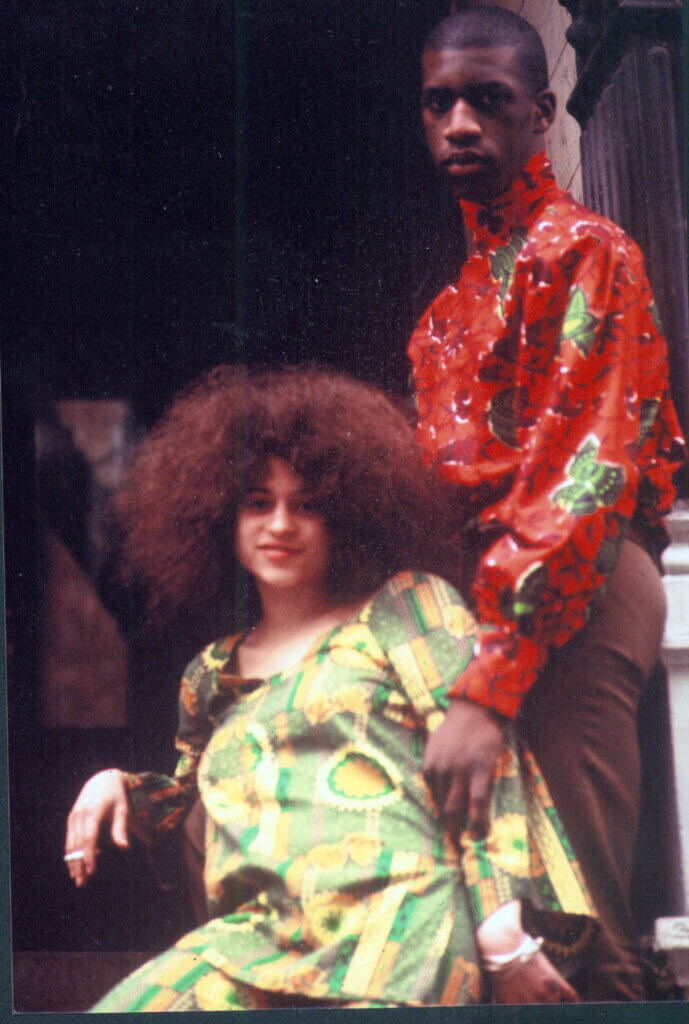
SH: Moving on to comics… How has fashion influenced your relationship with comics as a reader and a creator? Of course, I was thinking about your love for Matt Baker and Gladys Parker and how you do similar things as these artists in your comics.
TR: Matt Baker was amazing! He drew such great women and he knew clothes. He really understood clothes. And this is at a time when the average male cartoonist really didn’t know clothes. I mean the typical dress the average male cartoonist would put a woman in was your basic, very, very simple v-neck, bright red dress. And that’s what they would do. They would have, you know, a dress they would put women in. But Matt Baker really understood clothes. And I recently heard Matt Baker was gay and this makes a lot of sense to me, because gay men really do understand clothes.
When I did my reader-designed clothes in Misty and California Girls I would get some great designs by men and I knew, I knew they were gay and, of course, later I found out they were. And I took that for granted.
SH: I love the use of paper dolls in your comics, and you’ve talked about how as a child you would make them when you couldn’t have the clothes you wanted. I was wondering if you could talk about how that went into your love for comics?
TR: Well, since I was a child, I was maybe ten or eleven years old, I was designing paper dolls for grown women. You know, my paper dolls were always grown women. In my mind, twenty—twenty years old, that made you a grown woman. But, I was actually designing clothes for myself. I was designing dream clothes for women.
SH: You’ve talked a lot about how clothes create a sense of belonging and I feel that comes across in your discussions about the paper dolls in your comics, especially regarding the men who sent you letters.
TR: Well, they would send in the clothing designs and I would publish them. It meant that they were part of this special group. Some of the guys were older and they were incredible and I’ve known them since. They’ve been friends. There was one designer, he sent me pencils and all I did was ink them, I didn’t even draw them, they were so gorgeous. And there were the little bitty kids and you would look at those designs and you would have to completely redraw them, but I kept the essence. They were really adorable, the ones from the little bitty kids.
SH: I think the paper dolls in California Girls were very charming.
TR: Oh, in California Girls, the paper dolls were on better paper, because it was Eclipse, so I would get very creative. I would get some where you could fold them and make them into three dimensions and once they were published I would cut them out and make sure they would really work. They always worked.
SH: That’s smart, because some of the early comics didn’t do that, they didn’t put tabs on the paper dolls.
TR: Katy Keene always did, but there were others. Millie the Model, they didn’t include tabs. They [the creators] never played paper dolls so they didn’t understand that you have to cut them out and fasten them with tabs. They didn’t understand that. You could tell by looking at it that these were guys who never played paper dolls. And, by the way, I have a story about that. It was the Misty books. I was at a convention and these girls came over and they told me that they loved my Misty comics and that they loved my paper dolls and I asked them. “Did you cut them out?” and they said, “No, our father won’t let us cut them out.” So, I said, “Bring him over.” They brought him over and I explained to him that they were meant to be cut out. That you have to cut them out and play with them. They’re not just to keep, and that if you want a set of the books just to keep, that he should buy them for himself, but if he buys them for the girls and they want to cut them out that’s what it’s for.
SH: You can’t deny girls that pleasure. There is just a certain age where paper dolls are really magical.
TR: He didn’t understand because he didn’t play with paper dolls.
SH: Have you used clothing to define the personalities or identities of your comic book characters?
TR: In the teen comics there’s always one punk girl and she always dresses more outlandish than other characters, and her hair color is always more unusual.
SH: As a twin, I always liked how you dressed the twins.
TR: Oh yes!
SH: I love how they’re similar but different.
TR: Oh yeah, of course. To me, that’s very obvious, but I didn’t think of that when I met you and your sister, but of course you’d like California Girls. They’re twins. [The interviewer has an identical twin sister who met Robbins at SDCC 2018.] I used to have a little drawing of them tacked up on my drawing board so that I would remember which side of their head they each parted their hair on, because that’s the only difference.
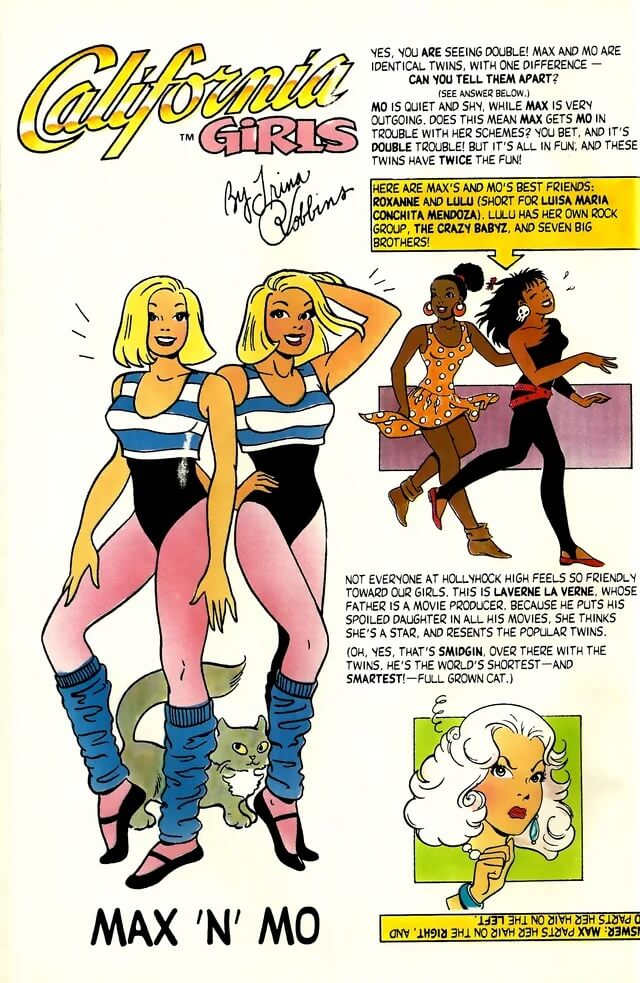
SH: I wanted to know, have you always felt there was a connection between comics and fashion?
TR: Well of course. When I was younger, some of the first comics that I read, some of the ones I liked the most, were of fashion, like Katy Keene. So, I always took it for granted that there was a connection. I mean, I never liked the superheroes. They were so boring. I couldn’t stand them. I also of course was reading Fiction House comics with the Matt Baker stories.
SH: There’s really no one like him around.
TR: No.
SH: On a similar theme, in the past, we have talked about the importance of having fashionable clothes in comics. Why do you think it’s so important to put comic book characters in fashionable, or just relatable clothes? You’ve talked a lot about how you couldn’t relate to and how it’s hard to relate to superheroes because they’re put in these horrible clothes.
TR: Oh, I hate superhero costumes. You know, first of all, those colors—those bright, bright clashing colors and then the outfits. I mean, they’re… they’re just ugly. The outfits are simply ugly. I wouldn’t wear that. I mean there was a period, you know, back in the nineties, I think ninety-six, maybe when I did my book on superheroines—I can’t remember when that was.
SH: I think it was ’98. [Editor’s note: so close, but it was published in 1996.]
TR: So, I put together a superheroine costume to wear when I did signings and my costume was adorable. It was a miniskirt—not too short—-because at that point, I felt I couldn’t wear them too short. I was getting too old. But it was bright red with white stars and I still have the skirt. I had bought it in a London Flea Market. I had to go all the way to London to find a skirt, and, in fact, the owner of the booth was out to lunch so we had to hunt him down so I could buy the skirt from him. And the jacket… where did I find the jacket? You know, I think I found it in one of those clothing trade places where you either buy or sell or trade clothes. It was a kind of a silver, pleather jacket that zipped up the front and the shoes. The shoes! The shoes I got in South Korea at the Namdaemun Market. It was a pile, a veritable mountain. It was a mountain of shoes for sale and of course, they were all small sizes because Koreans are small, but so am I, so it was perfect. They were silver, lace-up shoes with thick soles. That was my superheroine outfit. And it was perfect. And that’s what superheroines should wear.
SH: I agree. I’ve read a lot of the Ant-Man and Wasp comics and there are some times when Janet Van Dyne is putting together good costumes where I can see someone would wear them and there are other times when she is putting together this really ridiculous outfit where there is just no way—it has to be cute and it has to be functional.
TR: Yes, and of course, since the nineties really there has been that element of just extremely sexual costumes. You know, where they’re practically naked and fighting crime. With all that exposed skin. Just this morning I was going through my Facebook and I saw this drawing that someone had done of Dagger and she’s wearing this thing where it’s cut out to look like a dagger and it has flaps and wouldn’t they just flap open?
SH: That’s absurd.
TR: No, it really was just the worst and the most impractical and the silliest and the ugliest.
SH: Something would just slip out.
TR: Yes, exactly.
SH: But then you have comics like Katy Keene and the Betty and Veronica comics which had some cute clothes in them. I feel like when you read those, or when I read those as a girl it was exciting to see these clothes and it made me want to read the comics more.
TR: Well, you know, the teen comics were meant for girls and they’re still meant for girls, and boys, but mostly girls. You can tell—it’s almost a sign that a comic is meant for women or girls when they have great clothes.
SH: I do like the original Catwoman costume in the early Batman comics.
TR: Oh, the original outfit, the long skirt with the slit up the front—I loved that.
SH: I want to talk about Gladys Parker. You made this beautiful book about Gladys Parker. I see so many parallels between your career and her career: you both did clothing, you both did comics—I want to know what it was like to write that book.
TR: Well, it was fantastic finding out all about her and, you know, my source was newspapers because they wrote about her a lot. She was in so many gossip columns. They just loved writing about her. So, that was basically how I found out about her. And photos, she was so cute! She was so—I mean, I just can’t stand it, she’s so cute. She’s so cute, she doesn’t look real. She’s just so darling. And, god, I wish I could have lunch with her. Just once. Maybe in the afterlife. Maybe she’ll be there and I’ll be there. But I just loved finding out about her. Of course, there was just so much I couldn’t find out about her, but I found out an amazing amount. I loved her ten-year romance with [boxer and actor] Slapsie Maxie Rosenbloom. It’s just fantastic.
SH: She had a car!
TR: She had a car. She knew she was great. She did her own publicity. She didn’t need a publicist. She had a car that she had [her comic character] Mopsy painted on the door so that when she drove through Hollywood, everyone knew that was Gladys Parker in that car.
SH: I feel like she really shows when you dress well and when you participate in the celebratory nature of fashion, everyone always remembers.
TR: Someone told me, a woman friend of mine, that whenever I talk about various women in real life, I always describe what they were wearing.
SH: Yes, I’ve noticed that. I feel like you see the world through fashion and clothing and you create a community around it and you celebrate people through clothing, and you see that throughout your memoir.
TR: I didn’t even realize I did that. It was just automatic. It’s the way I think.
SH: Every time I see you talking to someone you always compliment their clothes or you notice something about someone’s outfit that you like. It’s very fun. It’s a very fun way to see the world I think.
TR: I compliment people on the street, always. When I see someone wearing something great, including men, I always say, “Wow, I love those pants,” or whatever.
SH: I want to get to your memoir a bit more. In Last Girl Standing, you write that the major reason you love clothes so much is that you didn’t have any nice clothes and you often wore your sisters’ or your cousins’ hand-me-downs. So, I think that there is this freedom in clothes that you speak to.
TR: I have simply always loved clothes. Obviously, even when I was ten or eleven years old my mother would buy me one dress a year, believe it or not, for school. It was always a dress that I wore on the first day of school. Usually a plaid dress for some reason. I guess kids, we just wore plaid. When I got old enough, there were certain clothes I really wanted. You know, the story of the Nylon blouse—I wanted one so badly because that was the latest thing. When my landlady gave me one, as a gift, I wore it to every single—every dress-up occasion, I wore that Nylon blouse.
SH: I had a similar thing with glitter combat boots.
TR: My big sister had fancy party shoes that had a little bitty heel, it wasn’t really a high heel, but maybe it was thinner than the average heel, skinnier, and a tiny bit higher and I just couldn’t wait for her to grow out of those shoes so that I could get them. I wanted them so badly.
SH: You also talk about Ann, [also known as] Vali Meyer, and how you would use clothing to emulate her or embrace this idea using black tights and black turtlenecks. I just love this idea of using clothing to create a version of yourself.
TR: I associate clothing with what you do. I mean, one thing is, in my book, I talk about how I took French in high school because I wanted to go live in Paris and be an artist and I couldn’t wear a beard, but I was going to wear a beret. I was going to be an artist in Paris and wear a beret. The beret is a very important part of it.
SH: Last question. What has it been like to be a fashion-loving, feminine woman in this male-dominated field?
TR: The fashion comics I’ve done, I’ve done for the girls and the gay guys and if the boys don’t get it that’s okay. That’s their problem.

